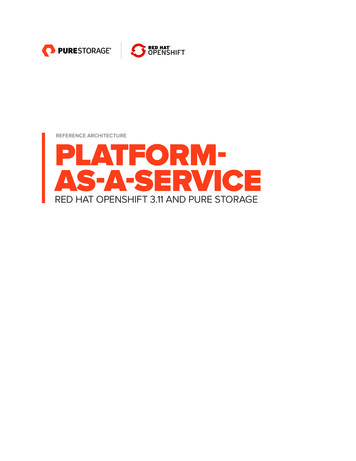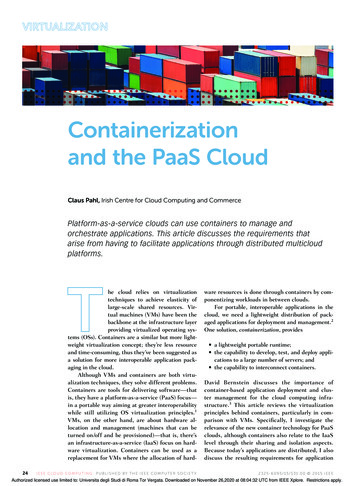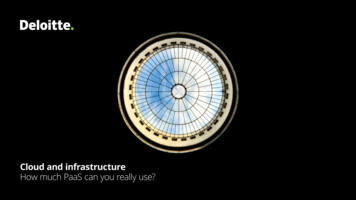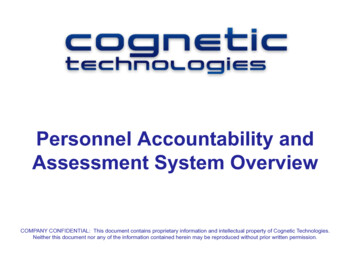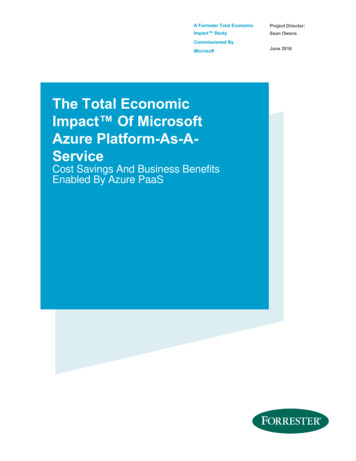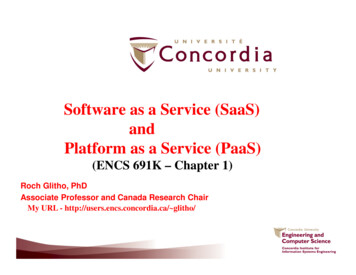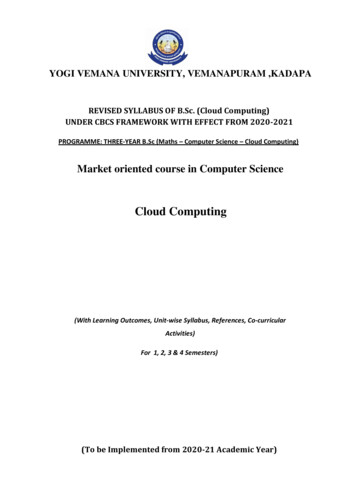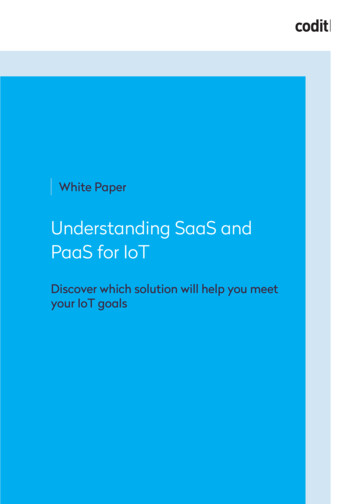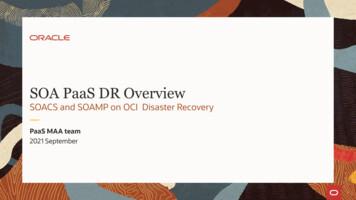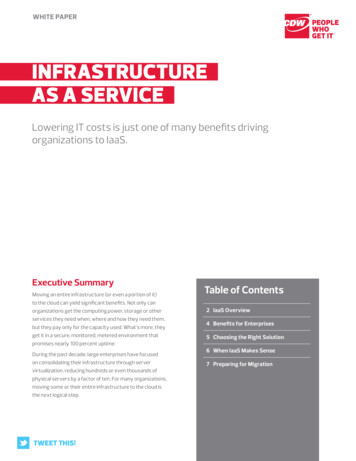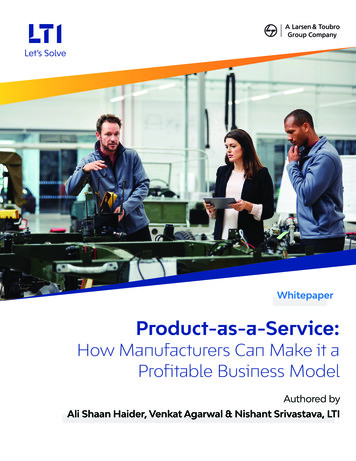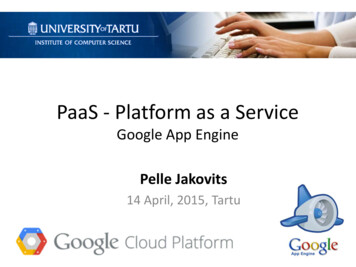
Transcription
PaaS - Platform as a ServiceGoogle App EnginePelle Jakovits14 April, 2015, Tartu
Outline Introduction to PaaS Google Cloud Google AppEngine– DEMO - Creating applications– Available Google Services– Costs & Quotas Amazon Beanstalk& Elastic MapReduce Windows Azure PaaS PaaS Advantages & Disadvantages2
Cloud Services3
Platform as a Service - PaaS Users are provided with a full platform for theirapplications Enables businesses to build and run web-based,custom applications in an on-demand fashion Eliminates the expense and complexity ofselecting, purchasing, configuring, and managinghardware and software. Provides access to unlimited computing power Decreasing upfront costs dramatically4
PaaS Characteristics Multi-tenant architectureBuilt-in scalability of deployed softwareIntegrated with web services and databasesUsers are provided with tools to simplifycreating and deploying applications Simplifies prototyping and deploying startupsolutions5
PaaS Characteristics Users only pay for services they use More fine grained cost model Provides tools to handle billing andsubscription management Typically introduces vendor lock-in6
Types of PaaS Stand Alone Application Platforms– Typically built on top of an existing IaaS– Provides development tools for designing and deploying software.– Provide all required computing resources and services needed forhosted applications Social Application Development Platforms– Used to develop addons and internal applications for social websiteslike Google and Facebook.– Integrated API with the social website platform.– Can be seen as extending a SaaS Open-Computing Platforms– Not tied to a single IaaS provider.– Supports applications that are written in numerous languages and thatuse any type of database, operating system, and server.7
Google Cloud Iaas & PaaS services All services built ontop of Google hardwarelocated across the globe Global redundancy and service locality Utilizes Google’s Global network– Dedicated fiber optic networks– Even between continents Google Managed Services– Database administration, server configuration,sharding and load balancing managed for the user8
Google Cloud Services Compute Engine - IaaS App Engine - PaaS Storage– Cloud SQL – Fully managed Relational MySQL– Cloud Storage – Object storage for applications– Cloud Datastore – Automatically scaled NoSQLstorage Big Data– Big Query – SQL like queries against multi-terabytedatasets9
Google Cloud Tools Cloud Endpoints– RESTful services to make your code accessible from iOS,Android and Javascript clients. Google Cloud SDK– For creating and managing Google cloud services Push-To-Deploy – Git repository to access your code Cloud Playground – Browser access to all GoogleServices10
Google Cloud Product Lines Mobile– Automatic scaling and load balancing From hundreds to millions of users Scaling up to 6 billion requests a day– Dedicated hosting for serving static content Hadoop Data Processing– Run at Scale – MapR used Google Compute Engine to set a new worldrecord for MinuteSort, sorting 1.5 trillion bytes in 60 seconds. Gaming– Synchronize game state across multiple devices– Analyze user engagement– Distribute and monetize your game with Google AdSense and GoogleIn-App Payments.11
Google App EngineTry it out yourself DEMO @https://developers.google.com/appengine12
Google AppEngine Easy to build, maintain, and scale applicationsNo servers to maintain yourselfUpload & GoWas created before Google Cloud becameavailable for public use Supported languages– Python, Java, PHP (preview), Go (Experimental)13
App Engine Characteristics Persistent storage with queries, sorting, and transactions App Engine distributes user requests across multipleservers and scales servers to meet dynamic trafficdemands. Asynchronous task queues for performing work outsidethe scope of a request Scheduled tasks for triggering events at specified times orregular intervals Integration with all other Google cloud services and APIs Your application runs within its own secure, sandboxed andreliable environment that is independent of the hardware,operating system, or physical location of the server.14
Use Cases Rovio– Transition “Angry Birds” games to an online environment– Use a platform that could support explosive demand– Easily add new features to improve the user experience Ubisoft– Develop a web-based version of a console game “From Dust”– Find an easy-to-use system so developers focus on the userexperience– Scale effortlessly to accommodate a fast-growing number of players Best Buy– Quickly develop and deploy apps to achieve its business goals– Create apps that are scalable and low-maintenance– Dramatic time and cost savings in app development, which has led tothe creation of many more apps15
Datastore Google Cloud SQL - A fully-managed web servicethat allows you to create, configure, and userelational databases that live in Google's cloud. Datastore - A schemaless object datastoreproviding robust, scalable storage for your webapplication, a rich data modeling API, and a SQLlike query language called GQL. Blobstore - Allows your application to serve largedata objects, such as video or image files, that aretoo large for storage in the Datastore service.16
Datastore Search - Allows your application to performGoogle-like searches over structured data suchas: plain text, HTML, atom, numbers, dates,and geographic locations. Memcache - A distributed, in-memory datacache to improve application performance. Logs - Provides programmatic access toapplication and request logs from within yourapplication.17
Communication Channel - Creates a persistent connection between your application andGoogle servers, so you can send messages to JavaScript clients in real timewithout "polling." Google Cloud Endpoints - Enables automatic generation of APIs, making iteasier to create a web backend for web clients and mobile clients Mail - Sends email messages on behalf of administrators and users withGoogle Accounts, and receives mail at various addresses. URL Fetch - Uses Google's networking infrastructure to issue HTTP andHTTPS requests to URLs on the web. XMPP - Enables an application to send and receive chat messages to andfrom any XMPP-compatible chat messaging service. Traffic Splitting - Allows you to roll out features for your app slowly over aperiod of time. Traffic Splitting works by splitting incoming requests todifferent versions of your app.18
Process management Task Queue - Allows applications to perform workoutside of a user request, and organize that workinto small, discrete units, called "tasks," to beexecuted later. Scheduled Tasks - Allows applications toconfigure regularly scheduled tasks that operateat defined times or regular intervals. Remote - Lets external applications transparentlyaccess App Engine services. For example, you canuse Remote API to access a production datastorefrom an app running on your local machine.19
Computation Backends - Instances of your application that areexempt from request deadlines and have accessto more memory and CPU resources. Images - Manipulates, combines, and enhancesimages, converts images between formats, andqueries image metadata such as height andfrequency of colors. MapReduce - An optimized adaptation of theMapReduce computing model for efficientdistributed computing over large data sets.20
Other services App Identity - Gives code access to the application identity;provides framework to assert this identity over OAuth. Users - Allows applications to sign in users with Google Accounts orOpenID, and address these users with unique identifiers. Capabilities - Provides detection of outages and scheduledmaintenance for specific APIs and services, so that yourapplication may bypass them or inform your users. Multitenancy - Makes it easy to compartmentalize your datato serve many client organizations from a single instance ofyour application. PageSpeed - A family of tools that automatically optimizes theperformance of your application.21
AppEngine for Mobiles Define business logic on App Engine and access themvia RESTful APIs on multiple platforms includingAndroid, IOS and JavaScript. Deploy an app in 300 seconds Automatically generate strongly-typed client librariesfor iOS, Android, and JavaScript. Geo-proximity search Push Notifications to iOS and Android Simple access to data storage and processing Might not make sense if your mobile application doesnot need to be connected to internet22
AppEngine for Mobiles23
24
IaaS Pricing Model Per instance hourPer storage amount/monthPer Network bandwith/monthPer additional services– Static IP– Autoscaling/load balancing25
PaaS Pricing Model26
PaaS Pricing Model27
AWS Elastic Beanstalk Languages: Java, .NET, PHP, Node.js,Python, Ruby, Go Platforms: Docker , Apache, Nginx,Passenger, and IIS. Automatically handles deployment, capacityprovisioning, load balancing, auto-scaling,application health monitoring. More manual control available (and required)28
Amazon Elastic MapReduce Managed Hadoop Platform– Resource provisioning, cluster setup, tuning– Quarantees reliability and scalability– Still flexible with full access to cluster if needed MapReduce, Spark, or other Hadoop supportedengines Input and output into S3, DynamoDB or otherAWS datastores Cheaper thanks to spot and reserved instances29
Windows Azure Hybrid PaaS & IaaS cloud platform Designed more for enterprise applications Programming languages– NET, Java, PHP, Node.js, Python, or Ruby Datastores– Azure SQL database and NoSQL storage Mobiles– Native SDK’s for Windows, iOS, Android and HTML5– Notification hubs for push notifications (Windows,iOS, Android)30
Windows Azure BigCompute– HPC on demand– MPI applications with Remote Direct Memory Access(RDMA) HDInsight– Seting up dynamic Hadoop clusters for Data Analyzis Examples of applications running in Azure:– Office 365, Skype, Bing, and Xbox– WebZen, Toyota Gazoo.com, HALO31
Other PaaS Examples AppScale––––Open-Source frameworkSupports Google App Engine Applications.Supports MySQL Clusters, HBase, Hypertable, and Apache CassandraPython, Go, and Java applications. Cloud Foundry– Cloud Foundry is an open-source PaaS platform that supportsprogramming languages Java and Scala. AppFog– Supports Java, Node, .Net, Ruby, PHP, MySQL, Mongo, PostgreSQL– Choose your own Cloud Provider. Heroku– Was one of the first PaaS services offered on the market– Supports Ruby, Java, Scala, and Python applications32
PaaS Advantages User does not have to manage low level computingresources and services Provider handles most of the non functional requirementsof your applications Scaling is automatically managed by the platform Easier and Agile application deployment– Simplifies prototyping and application startups Lower costs– Pay for only what is used– More fine-grained cost model than in IaaS Platform provider has the best knowledge to optimize theservices running on the underlying hardware33
PaaS Disadvantages Not in full control over:– Computing resources (Intel vs AMD, GPU’s, FPGA, )– Software and library versions– Service configuration Available programming languages are typically limitedVendor lock-inOffered services may not be flexible enough for user needsHave to fully trust in the PaaS provider––––Billing accuracySecurityReliabilityData ownership What happens when application exceeds billing quotas?34
Thats All This weeks practice session is:–Creating and deploying GoogleAppEngine applications using python Next lecture: Other Cloud Services35
Other PaaS Examples AppScale -Open-Source framework -Supports Google App Engine Applications. -Supports MySQL Clusters, HBase, Hypertable, and Apache Cassandra -Python, Go, and Java applications. Cloud Foundry -Cloud Foundry is an open-source PaaS platform that supports programming languages Java and Scala. AppFog
